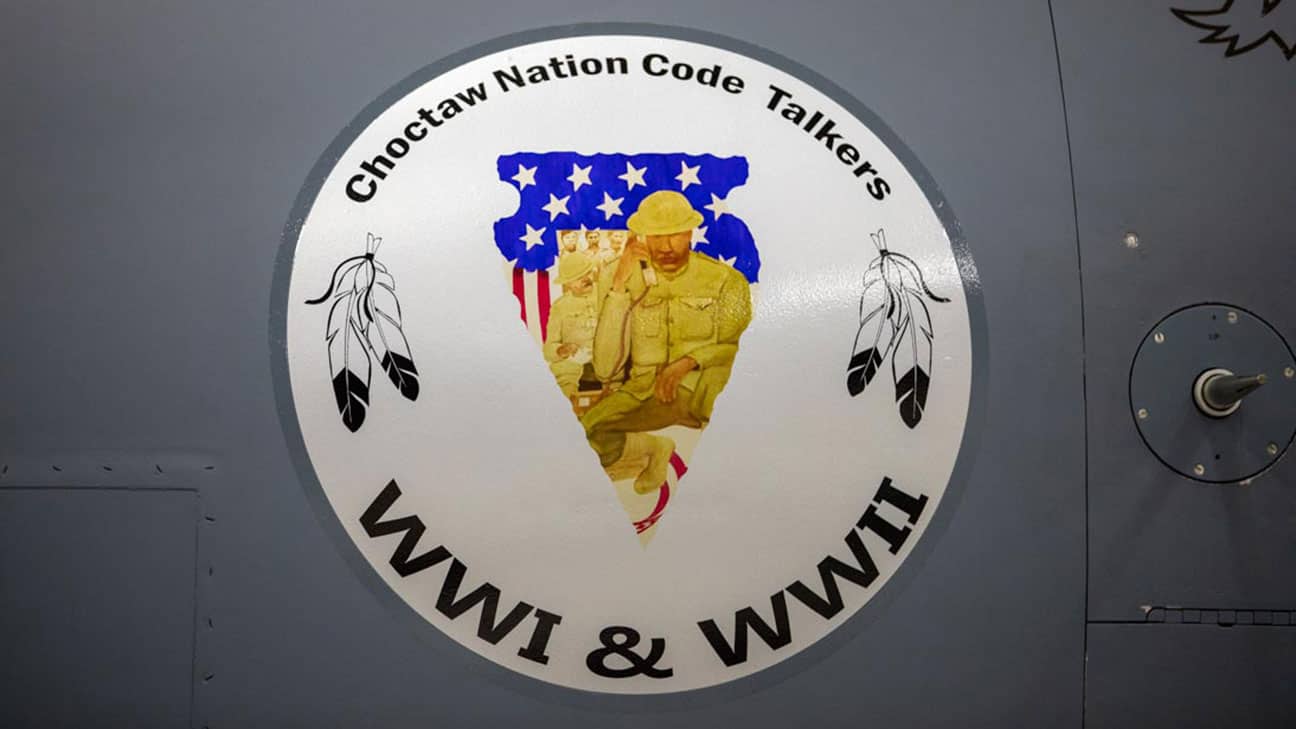
Robert Holster worked over 30 hours on the artwork honoring the Choctaw Code Talkers on the nose if this F-15 fighter.
Robert Holster and Oregon Air National Guard pay tribute to Choctaw Code Talkers with aircraft art
Published June 1, 2022By Christian Toews
The Oregon Air National Guard held a ceremony on April 14, 2022, to dedicate the nosecone of one of their F-15 Eagle fighter aircraft with artwork that honors the Choctaw Code Talkers who served in WWI.
Chief Gary Batton and Assistant Chief Jack Austin Jr. attended the event, and Batton addressed the audience in the Choctaw language during the ceremony.
Staff Sergeant Robert Holster is the Dedicated Crew Chief for the decorated jet. Holster designed the artwork and said that he was inspired by Choctaw artist Gwen Coleman Lester’s work.
“I drew the arrowhead because it’s significant to the original code talkers. It was part of the original artwork when the code talkers were called The Telephone Warriors,” said Holster.
According to Holster, the artwork took over 30 hours to design and draw.

Holster would spend any downtime working on the art using mostly applications on his phone. After the artwork design was complete, he had help from other colleagues on his base to enlarge the art and prepare it for placement on the nose of the aircraft.
He said the idea for the nose art came from learning the history of the Choctaw Code Talkers from WWI. Their bravery inspired him. He hopes the nose art honors their service and helps educate people about the code talkers who served in World War I.
“Honoring and continuing to honor our code talkers is important to me. I feel like they are honored, and they are proud to look down on us. I can tell other crew members about the history of it. I just hope that people remember that piece of history,” said Holster.
Holster began his career with the Air National Guard after a divorce. He had an extensive career as a firefighter and had worked his way up to an engine captain. He began to make some bad decisions while going through the divorce. He said that he knew he needed more discipline and direction in his life. “I just kept driving past the recruiters, and every time I would feel that I needed to stop and talk to them. After the third time I drove by, I decided to stop and talk to them. The recruiter was honest, and everything he said would happen happened. I really enjoy what I do now,” said Holster. It was essential to know what would happen in his Air National Guard career because he had to care for his children, and leaving his children for basic training was one of the most challenging things he has ever done. “But since then, my career here has been nothing but positive,” said Holster.
Holster’s 18 years of experience as a firefighter helped him earn a silver star. He said that another part of his mission as an Air National Guard member is to support the state of Oregon with any emergency response.
With his previous fire experience, he volunteered to help with the numerous wildfires that Oregon faces each year. In 2017, he assisted the firefighters when his Sergeant approached him and told him that he had a member down.
Holster immediately ran to the injured firefighter’s location. After making his way to the injured firefighter, he assessed that the individual had a severe heat-related illness and injuries. The firefighter was incapacitated and needed rescue, so Holster transported the firefighter over two miles through rugged terrain to get him to safety and ultimately saved his life. He was awarded a silver star for this act of bravery and fast recognition.
Holster said having his artwork that honors the WWI Code Talkers put on his aircraft was an exciting and memorable experience despite all of these accomplishments.
“At Kingsley Field, it’s unique to have the opportunity for nose art, as most Air Force aircraft have lost this customary practice. When I became the crew chief on this jet, it didn’t have any nose art. I took the opportunity to not only honor military tradition but also honor my heritage as a Choctaw Native American. I would like to thank our Wing Commander Colonel Edwards and Maintenance Group Commander Colonel Bouma for continuing this tradition and allowing my design to get approved and placed on the nose of the jet,” he said. “I’m deeply grateful to share part of my heritage and to honor these amazing and groundbreaking warriors from the Choctaw Nation through this nose art.”